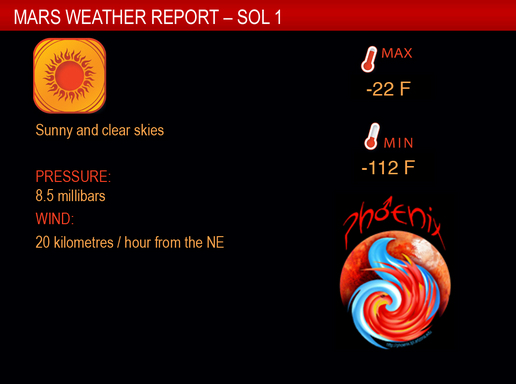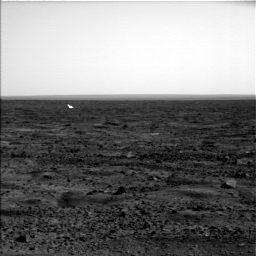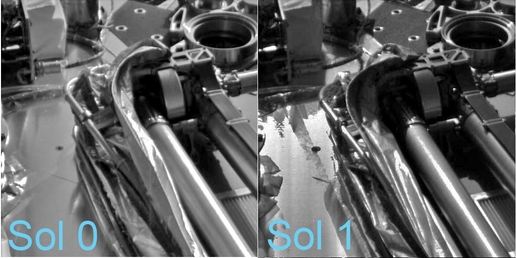The UHF communications radio on board the Mars Reconnaissance Orbiter has switched to standby and was unable to relay instructions to the Phoenix lander for its activities for sol 2, which included unstowing its robotic arm. The problem arose at 0608 PDT on Tuesday. MRO did receive the sol 2 sequence from Earth – meaning the communications link between Earth and MRO continues to operate normally. But subsequently MRO reported that there had been a “problem with the handshake between MRO and Phoenix,†said Fuk Li, manager of NASA’s Mars Exploration Program. A ‘handshake’ is the set of signals the radios on the two spacecraft send each other to establish a data-communications link.
“All this is is a one-day hiccup in being able to move the arm around, so it’s no big deal,” said Ed Sedivy, Phoenix program manager at Lockheed Martin Space Systems.
The next opportunity to send commands to Phoenix will occur on Wednesday morning, when Mars Odyssey, the other spacecraft used to communicate with Phoenix, passes over the landing site. At that time, the commands that failed to reach the lander today will be transmitted. We’ll keep you posted.
Also, we’ll take this opportunity to share a couple of other tidbits about Phoenix. The image above was taken on sol 1, and shows Phoenix’s backshell off in the distance.

On board Phoenix is a weather station, contributed by the Canadian Space Agency and University of Aarhus in Denmark. The weather station was activated in the first hour after landing on Mars. Measurements are being recorded continuously. Skies were clear and sunny on Sol 1 on Mars. The temperature varied between minus 112 degrees Fahrenheit in the early morning and minus 22 degrees Fahrenheit in the afternoon. The average pressure was 8.55 millibars, which is less than a 1/100th of the sea level pressure on Earth.
This image shows the spacecraft’s robotic arm in its stowed configuration, with the a biobarrier, a shiny, protective film, that covers the arm on landing day, or Sol (Martian day) 0, and then the biobarrier was removed during lander’s first full day on Mars, Sol 1.
The “elbow” of the arm can be seen at the top center of the picture, and the biobarrier is the shiny film seen to the left of the arm.
The biobarrier is an extra precaution to protect Mars from contamination with any bacteria from Earth. While the whole spacecraft was decontaminated through cleaning, filters and heat, the robotic arm was given additional protection because it is the only spacecraft part that will directly touch the ice below the surface of Mars. After Phoenix landed, springs were used to pop back the barrier, giving it room to deploy.
These images were taken on May 25, 2008 and May 26, 2008 by the spacecraft’s Surface Stereo Imager.
News Sources: Astrobiology Magazine, JPL Phoenix News



Oh don’t tell me the Mars “Triangle” has struck again!
Again with the Fahrenheit. Please convert to Celsius…
-22ºF = -30ºC
-112ºF = -80ºC
Just to set the record straight we in Canada use Celsius and I suspect NASA scientists are using Kelvin (same degrees, different 0 point i.e. -273 (and change) ºC). So a good Canadian weather station would be reporting in metric. The Fahrenheit is merely for the US public. Conversions were gratefully provided by Google.
Is it possible to translate the Fahrenheit to Celsius ?
-112F= -80C
-22F= -30C
Hehe, while I was converting the numbers someone was faster,is it possible to delete the posts ?
Huh…. was that actually a defense of the Fahrenheit scale…. seems to me that was basically…. If you understand Fahrenheit it makes sense to you?? For example, Temps like the 60s, 70s, etc, etc doesn’t mean anything to anyone unless you have experience with that scale?? I don’t see any big conceptual leap in understanding a range like 15-20 Celsius??
32°F is the freezing point of water and 212 °F the boiling point??? (180 points between…That makes plenty of sense! Seems pretty arbitrary and harder to calculate with?)
Anyway, I would also like to see Metric measurements if possible please… eventually we will all be using them.
Thanks for converting to metric guys, I truly appreciate it. 🙂
Ah that bastion of eminent sensibility – the Metric System.
I understand the need for imperial for the US audience as this is a popular science website, but Metric conversions would be a nice inclusion as standard…
question:
I dont know much about exobiology. Why is the reason for decontaminating the lander? or any planetary mission?
the most weighing explanation to me is to not confuse any contamination with native biological life in a specific planet.
I mean, not that they will prolifer in space envieronment so what’s the deal?
“I mean, not that they will prolifer [sic] in space envieronment so what’s the deal?”
What do you base that on? Microbes grow in much harsher environments on Earth.
Too many armchair scientist here.
“I understand the need for imperial for the US audience as this is a popular science website, but Metric conversions would be a nice inclusion as standard…”
Fahrenheit is a standard, and is in many ways a better gauge for climate temperature:
A notable feature of the Fahrenheit scale is that the broader range of temperatures experienced in a temperate climate span the scale generally from 0 to 100 degrees, whereas this range of temperatures would span the Celsius scale within the relatively small numerical range of -17 to 37 degrees. This results in decades, or ranges of 10 degrees of the Fahrenheit scale, being able to be used to describe the feel of a day’s temperature, i.e. “the 60’s” would indicate that the temperature falls in the distinctive range of 60° – 69° F. Stating such a range in Celsius could be considered to be a bit more awkward, as rather than saying “in the 60’s”, one would have to say something along the lines of “between 15 and 20”.
I should have converted, sorry. But it’s odd that the weather report, which is provided by the weather station that comes from equipment provided by Canada and Denmark, and both countries use the Celsius scale.
I have to strongly vote for metric units. It’s not just Canada, continental Europe is not using anything but them.
So, Kevin, to me it’s quite different: not only do i have no feeling of what fahrenheit “feels like”, i would have to look it up to be able to do the conversion.
(How) Are °F defined anyway? Wikipedia(en) cites at least five different ones.
I admit the temperature scale, when used to describe weather or climate, is one where I still feel the need to convert to Fahrenheit “to see what it’s actually like.”
It may be the longest holdout in the switch to a metric system. I thought the weather report was nice, so I dropped the link to this post in an email for a couple of friends and family — with no conversion needed since the temps were already in F.
Old habits die hard. I’m pretty good (at thinking Metric) in units of distance, volume, and weight, but still like to have my velocity/time (km/h) converted to mph when discussing ground-based speed and my temperature converted to F when discussing temperatures that relate to weather conditions (and HP and ft-lbs of Torque may never go away…).
I don’t think you can argue the efficacy of F vs. C, just the depth to which F is ingrained while C still feels unfamiliar. Conversions are good, either way.
Hey! I thought this post was about a commo glitch!!..
BTW, people – Astronomy uses metric. Thanks for using the “US†imperial measures, though. It’s what I use.. 🙂
They need the bio barrier because some bacteria is quite rugged. I read an article about making synthetic diamonds with presses that use diamonds as the pressure points to crush carbon into more diamonds and they guys doing that put some bacteria in the sample and crushed it. Even under some extreme pressure, some of the bacteria was still moving about and fine as a fiddle. Thats pretty hardy! So a space journey would be nothing to the right bacteria. Just imagine the fallout if they discovered “life on Mars” only to find out it was contamination from Earth!
I always thought that an interesting experiment would be to actually send some hardy strains of bacteria to Mars and see if any of them could survive. Maybe some fungi, too. We should first try to locate sites that we believe would be hospitable (to give them the best chance) and then turn them loose. I know that Mars is a Sacred Cow to some but to me it’s the ultimate laboratory for experimentation. Besides, if you really want to find life on another planet, the best way is to introduce a new life form that it can potentially feed on,
i.e bait!
Posted this link in http://www.surfurls.com
Matthias,
I don’t know how Fahrenheit is defined! I guess that’s sad. 🙁
I just know what a 40 degree day feels like, or a 72 degree day, or a 108 degree day…
From a standpoint of reason, of course I understand metric makes much more sense. I think it should be adopted, I think it should be used in science, etc. For many units, like length/distance, volume, weight, etc., I’m able to “think” in metric, but for whatever reason, when I see km/h I have to do a quick calc in my head (divide by 1.6 or so) and when I see degrees C I have to multiply by 1.8 and add 32 — I blame my parents! 🙂
I wouldn’t argue that non-metric is better, I’m just acknowledging I have a ways to go for some measurements, while some people I know don’t have much of a clue at all about metric equivalents. Maybe NEXT generation…
it’s really quite amazing that this equipment can operate in such cold temperatures. Very impressive.
This is the first time I commented here and I should say that you provide genuine, and quality information for bloggers! Good job.
p.s. You have a very good template . Where have you got it from?